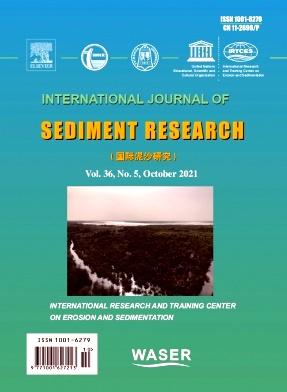Local erosion and mound formation induced by turbulent slurry wall jets in crossflow
IF 3.7
2区 环境科学与生态学
Q2 ENVIRONMENTAL SCIENCES
引用次数: 0
Abstract
This paper presents the results of experimental investigation on the local erosion and mound formation induced by slurry turbulent circular wall jets in crossflow and with the presence of a secondary current. The trajectory of the slurry jets with different intensities on the bed formation was measured with an accurate laser scanner with a resolution of ±1 mm. Other data such as scour, and mound areas and volumes were measured to study the effects of sediment concentration and jet’s intensity on deformation of erodible bed at the vicinity and downstream of the crossflow. Experimental results indicated that the mass flux of sediment in slurry wall jets increased the width and spreading rate of sediment mound while increasing the intensity of the jet reduced the mound width and stretched it along the flow direction. The correlation between non-dimensional geometry parameters with the jet’s Reynolds number indicated a distinct behavior on the development and direction of mounds with a threshold Reynolds number of approximately 36,000. For turbulent slurry wall jets with Reynolds number smaller than the threshold value, most of the sediments settled at the vicinity of the nozzle and reduced the scour depth while for stronger jets, sediment dunes were formed in the curved region of the flume and scour depth was almost the same as the scour depth formed by the corresponding clear water turbulent wall jets. A linear correlation was found between the peak scour depth and jet’s Reynolds number, while peak scour depth, area, and volume decreased with increasing the initial sand concentration of slurry jets. Empirical formulas were proposed for prediction of bed deformation and jet’s trajectory, the accuracies of the proposed models were evaluated using statistical analysis, and the performance of the proposed models were compared with the existing models from the literature.
横流中紊流浆壁射流引起的局部侵蚀和土丘形成
本文介绍了二次流作用下浆状湍流圆壁射流在横流条件下引起的局部侵蚀和土丘形成的实验研究结果。用分辨率为±1 mm的高精度激光扫描仪测量了不同强度浆液射流在床层上的运动轨迹。此外,还测量了冲刷、土丘面积和体积等数据,研究了沉积物浓度和射流强度对横流附近和下游可蚀层变形的影响。实验结果表明,浆壁射流中泥沙的质量通量增大了泥沙丘的宽度和扩散速率,而射流强度的增大减小了泥沙丘的宽度并使泥沙丘沿流动方向拉伸。无量纲几何参数与射流雷诺数之间的相关性表明,在阈值雷诺数约为36,000时,土丘的发展和方向具有明显的行为。对于雷诺数小于阈值的湍流浆壁射流,大部分泥沙沉降在喷嘴附近,使冲刷深度减小;而对于雷诺数较强的射流,泥沙沙丘在水槽弯曲区域形成,冲刷深度与清水湍流壁射流形成的冲刷深度基本相同。峰值冲刷深度与射流雷诺数呈线性相关,峰值冲刷深度、面积和体积随浆体初始砂浓度的增加而减小。提出了床层变形和射流轨迹预测的经验公式,利用统计分析方法对所建模型的精度进行了评价,并将所建模型的性能与已有的文献模型进行了比较。
本文章由计算机程序翻译,如有差异,请以英文原文为准。
求助全文
约1分钟内获得全文
求助全文
来源期刊
CiteScore
6.90
自引率
5.60%
发文量
88
审稿时长
74 days
期刊介绍:
International Journal of Sediment Research, the Official Journal of The International Research and Training Center on Erosion and Sedimentation and The World Association for Sedimentation and Erosion Research, publishes scientific and technical papers on all aspects of erosion and sedimentation interpreted in its widest sense.
The subject matter is to include not only the mechanics of sediment transport and fluvial processes, but also what is related to geography, geomorphology, soil erosion, watershed management, sedimentology, environmental and ecological impacts of sedimentation, social and economical effects of sedimentation and its assessment, etc. Special attention is paid to engineering problems related to sedimentation and erosion.

 求助内容:
求助内容: 应助结果提醒方式:
应助结果提醒方式:


